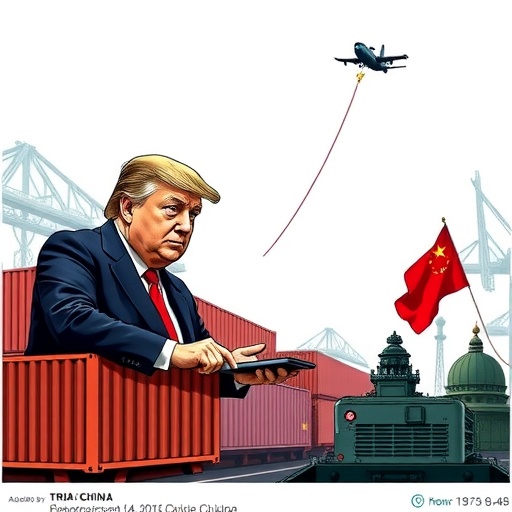Trump‘s 155% Tariff Warning to China Intensifies Trade Negotiations as US Eyes Global Alternatives
In a bold escalation of the ongoing trade tensions, President Donald Trump has issued a stark ultimatum to China, threatening to impose a staggering 155% tariff on Chinese imports if no comprehensive trade deal is reached by November 1. This move comes as the United States ramps up efforts to diversify its supply chains and forge new economic partnerships worldwide, signaling a pivotal shift in America’s economic policy toward reducing dependence on Chinese manufacturing.
- Trump’s Ultimatum Sets November 1 Deadline for China Deal
- US Courts New Trade Alliances to Sidestep China Reliance
- Economic Ripples: How 155% Tariffs Could Reshape American Markets
- China’s Defiant Stance and Global Trade Tensions Escalate
- Path Forward: Navigating Uncertainties in US-China Economic Standoff
The announcement, delivered during a White House press briefing on economic strategy, underscores Trump‘s long-standing aggressive stance on trade imbalances. ‘If China doesn’t come to the table with a fair deal, they’ll face tariffs like they’ve never seen before—155% on everything from electronics to apparel,’ Trump declared, emphasizing the deadline’s proximity. This threat arrives amid intensifying trade negotiations, where both nations have exchanged proposals but failed to bridge key divides on intellectual property rights, market access, and subsidies.
According to U.S. Trade Representative Robert Lighthizer, the administration’s strategy is designed to protect American workers and industries from what it describes as unfair Chinese practices. Data from the U.S. Census Bureau reveals that Chinese imports accounted for over $500 billion in goods last year alone, contributing to a trade deficit exceeding $300 billion. The proposed tariff hike could dramatically alter this dynamic, potentially reshaping global supply chains and boosting domestic production.
Trump’s Ultimatum Sets November 1 Deadline for China Deal
President Trump’s warning isn’t just rhetoric; it’s a calculated pressure tactic in the high-stakes arena of US-China trade negotiations. The November 1 deadline aligns with the midterm election cycle, allowing Trump to leverage the issue for political gain while pushing Beijing toward concessions. In recent weeks, negotiation teams from both sides have held virtual sessions, focusing on contentious areas like technology transfers and agricultural exports.
Trump elaborated on the tariff’s scope during an interview on Fox News, stating, ‘We’ve been too patient. China has been ripping us off for decades. This 155% tariff will make it impossible for their cheap goods to flood our markets.’ Economists estimate that such a levy could add billions to the cost of imported goods, with the U.S. International Trade Commission projecting a potential 20-30% increase in consumer prices for affected categories.
Historical context adds weight to the threat. Since 2018, the Trump administration has already imposed tariffs on over $360 billion worth of Chinese products, leading to retaliatory measures from Beijing that hit U.S. farmers and manufacturers hard. Soybean exports to China, for instance, plummeted by 75% in 2018 following initial tariffs, according to the USDA. Yet, Trump argues that these measures have spurred a resurgence in American manufacturing, with factory jobs growing by 400,000 since he took office—a figure his campaign frequently highlights.
To mitigate domestic fallout, the administration has allocated $28 billion in aid to affected sectors through the Market Facilitation Program. Critics, however, including Democratic lawmakers, warn that escalating to 155% could trigger a full-blown trade war, disrupting global economic stability.
US Courts New Trade Alliances to Sidestep China Reliance
As Trump turns up the heat on China, the U.S. is aggressively pursuing bilateral trade agreements with alternative partners, aiming to diversify imports and bolster supply chain resilience. Recent deals with countries like Vietnam, Mexico, and India highlight this pivot in economic policy.
For example, the U.S.-Mexico-Canada Agreement (USMCA), ratified in 2020, has already increased North American trade by 15%, per Commerce Department data. Negotiations with the United Kingdom post-Brexit are advancing, with talks focusing on reducing tariffs on automobiles and pharmaceuticals. ‘We’re building a network of fair trade partners who respect our rules,’ Lighthizer noted in a congressional testimony last month.
Asia emerges as a key battleground. The U.S. has inked a preliminary trade pact with Japan, slashing tariffs on $7 billion in agricultural products, and is in discussions with Australia to expand critical mineral imports—essential for tech and defense industries. Vietnam, once a minor player, now supplies 20% more electronics to the U.S. than in 2018, filling voids left by Chinese tariffs.
Statistics from the World Trade Organization show U.S. imports from China dropped 18% year-over-year in the first half of this year, while those from ASEAN nations rose by 12%. This shift isn’t without challenges; labor standards and geopolitical risks in new partners pose hurdles, but proponents argue it’s vital for long-term security. A PwC report estimates that full diversification could save the U.S. economy $100 billion annually in potential trade disruptions.
- Vietnam’s Surge: Electronics imports up 25%, creating 50,000 new U.S. jobs in assembly.
- India’s Potential: Talks on pharmaceuticals could redirect $10 billion in generics away from China.
- Mexico’s Role: Auto parts trade boosted by USMCA, reducing China dependency by 15%.
These alliances reflect a broader economic policy under Trump to ‘decouple’ from China, a strategy echoed by allies like the European Union, which is imposing its own tariffs on Chinese steel.
Economic Ripples: How 155% Tariffs Could Reshape American Markets
The prospect of a 155% tariff on China sends shockwaves through U.S. industries, promising both opportunities and pain points. Retail giants like Walmart and Target, heavily reliant on Chinese sourcing for everything from toys to textiles, could see profit margins shrink dramatically. Analysts at Goldman Sachs predict a 5-7% rise in inflation if implemented, hitting low-income households hardest.
On the flip side, domestic manufacturers stand to gain. Steel and aluminum producers, already buoyed by earlier tariffs, report a 10% production increase, per the American Iron and Steel Institute. ‘This levels the playing field,’ said Tom Bird, CEO of a Midwest steel firm, in a Bloomberg interview. Small businesses in apparel and machinery sectors could repatriate operations, with the National Association of Manufacturers forecasting 200,000 new jobs over five years.
Consumer impacts are stark. A study by the Peterson Institute for International Economics models that full tariffs would add $1,200 annually to the average household’s expenses, primarily through higher prices for electronics (up 25%) and clothing (up 18%). E-commerce platforms like Amazon might pass costs to buyers, altering shopping habits toward pricier American or allied imports.
Broader economic policy implications include fiscal strain. Tariff revenues, which topped $70 billion last year, could fund infrastructure but risk slowing GDP growth by 0.5%, according to the Federal Reserve. Stock markets reacted swiftly to Trump’s announcement, with the Dow dipping 1.2% and Chinese indices falling 3%, underscoring interconnected global finances.
- Short-Term Shock: Supply chain disruptions could halt 10% of U.S. imports temporarily.
- Medium-Term Gains: Boost to U.S. exports in agriculture, projected at $20 billion.
- Long-Term Shift: Accelerated automation and reshoring, enhancing economic sovereignty.
Experts like Harvard economist Dani Rodrik caution that while tariffs protect jobs, they may stifle innovation by raising input costs for tech firms dependent on Chinese components.
China’s Defiant Stance and Global Trade Tensions Escalate
Beijing’s response to Trump’s tariff threat has been measured but firm, with state media labeling it ‘economic bullying’ and vowing countermeasures. Chinese Foreign Ministry spokesperson Zhao Lijian stated, ‘The U.S. cannot bully its way to a deal; we will protect our interests through diversified markets.’ China has already deepened ties with the Belt and Road Initiative partners, exporting $1.3 trillion in goods last year.
In retaliation scenarios, experts predict tariffs on U.S. aircraft, soybeans, and LNG—key exports totaling $120 billion. The 2018 trade spat saw China pivot to Brazilian soy, cutting U.S. market share by 40%. Now, with trade negotiations stalled, China is accelerating domestic tech self-sufficiency via ‘Made in China 2025,’ investing $300 billion in semiconductors and AI.
Global reactions vary. The IMF warns of a 0.8% drag on world GDP from escalated U.S.-China conflict, while the WTO faces calls for mediation. European leaders, caught in the crossfire, are negotiating their own deals with China to avoid collateral damage, as seen in the recent EU-China investment agreement.
U.S. allies like Japan and South Korea express concern over supply chain fallout, with Samsung and Toyota warning of production halts. A Reuters poll of 500 global CEOs shows 60% believe the tariff threat will hasten de-globalization, fragmenting trade into blocs.
Amid this, Trump’s team remains optimistic, citing progress in phase-one deal implementation—China met 58% of purchase commitments last year, per USTR reports. Yet, core issues like subsidies persist, fueling the impasse.
Path Forward: Navigating Uncertainties in US-China Economic Standoff
Looking ahead, the November 1 deadline looms as a make-or-break moment in Trump‘s economic policy against China. If no deal materializes, phased tariff implementation could begin, starting with high-tech goods and expanding broadly. Negotiation breakthroughs remain possible; sources indicate backchannel talks on IP enforcement could yield concessions.
The U.S. Congress may intervene, with bipartisan bills proposing tariff exemptions for allies and incentives for reshoring. Internationally, forums like the G20 in November could host emergency sessions to avert escalation. For businesses, the uncertainty demands agility—many are stockpiling inventories and scouting suppliers in India and Eastern Europe.
Ultimately, this standoff could redefine global trade norms, prioritizing resilience over efficiency. As Trump pushes for a ‘America First’ agenda, the world watches whether trade negotiations will forge a new equilibrium or ignite prolonged economic friction. Stakeholders from Wall Street to Main Street brace for impacts, with the tariff’s shadow influencing everything from holiday shopping to investment strategies.










